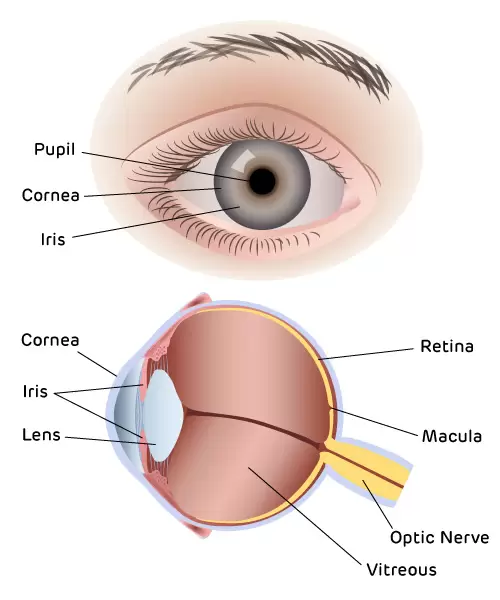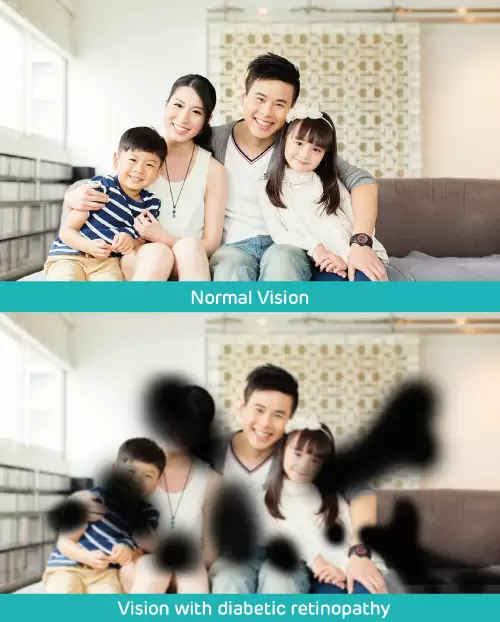
Pycnogenol®: Anti-Diabetic Retinopathy Remedy
Nov 15, 2019
What is Diabetic Retinopathy
1 in 5 Malaysians aged 18 years and above have diabetes1, and more than 70% of them will develop visual changes within 15 years of diagnosis2. Nearly all type I diabetics and more than 60% of type II diabetics will develop diabetic retinopathy (DR)3 – a microvascular damage in retina4.

Figure 1: Basic anatomy of the eye
The retina is a light-sensitive tissue that converts an image into a message which then sends to the brain for image recognition. Prolonged exposure to hyperglycemia will cause the retinal capillaries to leak and eventually lead to visual impairment. Figure 2 compares a normal vision and DR vision. According to research, DR is the leading cause of new blindness in people of working age group5.

Figure 2: Normal vision vs DR vision
How to Manage Diabetic Retinopathy?
Vision loss due to DR is preventable by early detection and medical management of diabetes. For instance, you shall get a regular comprehensive dilated eye examination at least once a year to save your vision. This check-up will allow your ophthalmologist to examine your eye more thoroughly for any signs of retinal damage before it is too late. Along with that, keep your health on TRACK!
T

Take your medications as prescribed by your doctor
R

Reach and maintain a healthy body weight
A

Add more physical activity in your daily life
C

Control your ABC’s:A1C, Blood pressure, and Cholesterol levels
K

Kick the smoking habit
Pycnogenol®: An Anti-Diabetic Retinopathy Remedy
Pycnogenol® is effective at preventing and stopping the progression of DR by the following actions:
- Pycnogenol® stimulates nitric oxide synthase; thus improves the retinal blood flow6
- Pycnogenol® strengthens retinal capillaries; thus prevents the retinal capillaries leakage7
- Pycnogenol® inhibits α-glucosidase activity; thus lowers the HBA1c level8
Pycnogenol® has been extensively studied for the past 40 years, and it has more than 400 published studies and review articles ensuring its safety and efficacy9. This patented and clinically proven extract from French Maritime Pine Bark Extract (Pinus pinaster) is suitable to be taken by all adults particularly individuals with long history of diabetes and uncontrolled blood glucose level.
This article is brought to you by BiO-LiFE Pycno®sight.
References
- Institute for Public Health (IPH) 2015. National Health and Morbidity Survey 2015 (NHMS 2015). Vol. II: Non-Communicable Diseases, Risk Factors & Other Health Problems
- Association of Malaysian Optometrists. Diabetes and the Eye available at http://www.amoptom.org/eyes-vision/eye-diseases/diabetes-and-the-eye/
- Fong D. S. et al. 2004. Retinopathy in diabetes. Diabetes Care, 27(1): S84-S87
- Mohamed A. H. et al. 2017. Statins effect on diabetic retinopathy among patients with type 2 diabetes mellitus. International Journal of Ophthalmology and Visual Science, 2(4): 106-114
- Beena R et al. 2017. Incidence of glaucoma and diabetic retinopathy in patients with diabetes mellitus in a teaching hospital. Journal of Medical and Dental Science Research, 4(5): 31-35
- Steigerwalt R, Belcaro G, Cesarone MR, et al. 2009. Pycnogenol® improves microcirculation, retinal edema, and visual acuity in early diabetic retinopathy. Journal of Ocular Pharmacology and Therapeutics, 25(6), 537-540.
- Spadea L and Balestrazzi E. 2001. Treatment of vascular retinopathies with pycnogenol. Phytotherapy Research, 15(3): 219-223.
- Zibadi S, Rohdewald P, Park D, Watson RR. 2008. Reduction of cardiovascular risk factors in subjects with Type 2 Diabetes by Pycnogenol® supplementation. Nutrition Research, 28: 315-320.
- Maritim A. C., Sanders R. A., Watkins J. B. 3rd. 2003. Diabetes, oxidative stress, and antioxidants: a review. Journal of Biochemical and Molecular Toxicology, 17(1): 24-38



